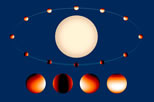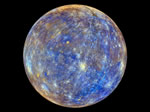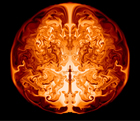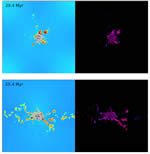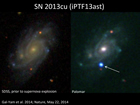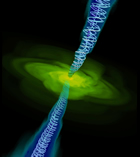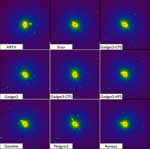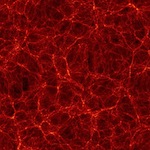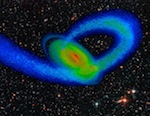Word doc
PDF (formatted and ready to go as a single newsletter page)
Milky Way: Cosmic Cannibal!
Get ready for a feeding frenzy! The supermassive black hole in the center of our Milky Way galaxy will grab an appetizer in June—right in time for prime summer viewing for northern-hemisphere astronomers!
From Earth, the center of the Milky Way is in Sagittarius near the border of Scorpius. The supermassive black hole, partly named for its host constellation, is called Sgr A* (pronounced “Sadge A-star”).
From radio astronomy measurements, the Schwarzschild radius of Sgr A*—that is, of its “event horizon” beyond which light cannot escape—is known to be a quarter the radius of Mercury’s orbit. But that entire volume is jam-packed with a mass 4 million times greater than our Sun.
Starvation diet
Weirdly, Sgr A* “is the most underluminous black hole observed,” remarked Peter Anninos of Lawrence Livermore National Laboratory in northern California, meaning it hardly glows. True, the very definition of a black hole is something so massive that not even light can escape. But supermassive black holes in many other galaxies are surrounded by gas, dust, and other material. When material falls into, or accretes onto, a black hole, it emits a broad spectrum of radiation most intense in X-rays.
SgrA* doesn’t glow, though, because “it is starved for material,” Anninos explains. Observations reveal that hundreds of hot young stars are whirling around SgrA* in orbits within 1 parsec (about 3 light-years). Measurements and calculations suggest
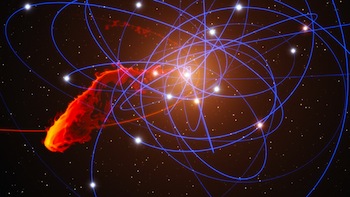
Simulations of the dust and gas cloud G2 (orange and yellow)
on its orbit around the Milky Way central black hole Sgr A* (invisible near center). White objects and orbits depict hot young stars whipping around the supermassive black hole.
Credit: M. Schartmann and L. Calcada, European Southern Observatory and Max-Planck-Institut fur Extraterrestrische Physik
their stellar winds blowing away the gas are so fast and furious that “it is difficult to actually get the gas down to the black hole.”
Within this environment, however, “Sgr A* may occasionally enjoy a relative feeding frenzy,” continues Anninos and his three coauthors from Livermore and the College of Charleston in South Carolina, writing in a November 2012 issue of The Astrophysical Journal. Maybe every 10,000 years or so a daredevil star zipping tauntingly close to SgrA*—about the Sun-Earth distance—might get torn apart by tidal forces and consumed. But that’s a long time between meals.
Cosmic cannibalism
Enter the hapless gas cloud G2. In 2011, three astronomers detected a small clump of dusty, ionized gas near the galactic center; dubbed G2, it has a radius of 2 to 20 billion kilometers (about as big as our solar system) and a mass triple Earth’s. G2’s dust is warm—550K, about twice Earth’s temperature; its gas is 10,000K, twice as hot as our Sun. But G2 is far cooler than the heated, rarefied gas at the galactic center. Because cool clouds in such a hostile environment evaporate, G2 either formed shortly before it was detected or is part of a larger extended structure.
Like a comet heading toward the Sun, G2 is plummeting toward Sgr A*. At closest approach (pericenter) in June, G2’s center of mass will scream by only 4 billion kilometers
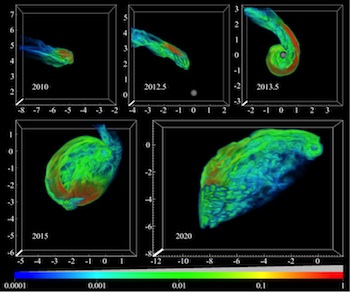
Three-dimensional volume visualization spanning the period 2010 to 2020, of the gas and dust cloud as it approaches the Sgr A* black hole near the center of the Milky Way galaxy at five points from 2010 to 2020. Credit: Chris Fragile and Julia Wilson
away, scarcely more than 3,000 times the Schwarzschild radius of Sgr A*. Although too distant for G2 to be gulped whole (just as only rarely do sun-grazing comets actually plunge into the Sun), computer simulations reveal that enormous tidal forces will elongate G2 until it begins to fragment and lose angular momentum through interactions with background gas. “The cloud stretches into a stream of gas feeding the black hole,” Anninos explains.
The show will start in June and unfold through 2020.
What might observers actually see? Astronomers are excited to find out. Calculations suggest that while SgrA* won’t turn the center of the Milky Way into an AGN (active galactic nucleus), it could brighten by more than 100 times the luminosity of our Sun, mainly in X-rays. With the right equipment,“this event should be easily observable over the next several years,” Anninos estimates. “The break up of G2 will provide an unprecedented opportunity to study accretion physics in the galactic center.”
–Trudy E. Bell, M.A.
Further reading: Link to the paper in The Astrophysical Journal is at http://arxiv.org/abs/1209.1638. A Lawrence Livermore press release is at https://www.llnl.gov/news/newsreleases/2012/Oct/NR-12-10-07.html . A movie of the simulation of G2 being captured and eaten through 2020 is at http://fragilep.people.cofc.edu/research/movies/cloud_new.mov .
The University of California High-Performance AstroComputing Center (UC-HIPACC), based at the University of California, Santa Cruz, is a consortium of nine University of California campuses and three Department of Energy laboratories (Lawrence Berkeley Laboratory, Lawrence Livermore Laboratory, and Los Alamos National Laboratory). UC-HiPACC fosters collaborations among researchers at the various sites by offering travel and other grants, co-sponsoring conferences, and drawing attention to the world-class resources for computational astronomy within the University of California system. More information appears at http://hipacc.ucsc.edu .
